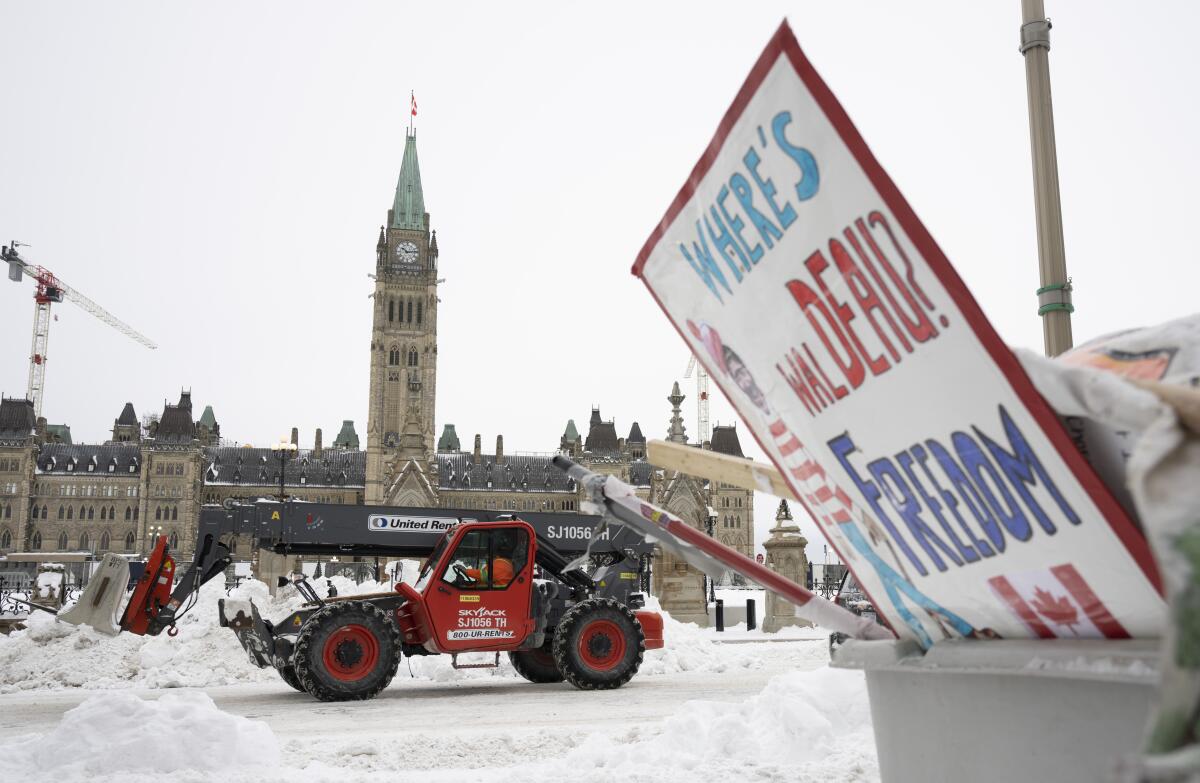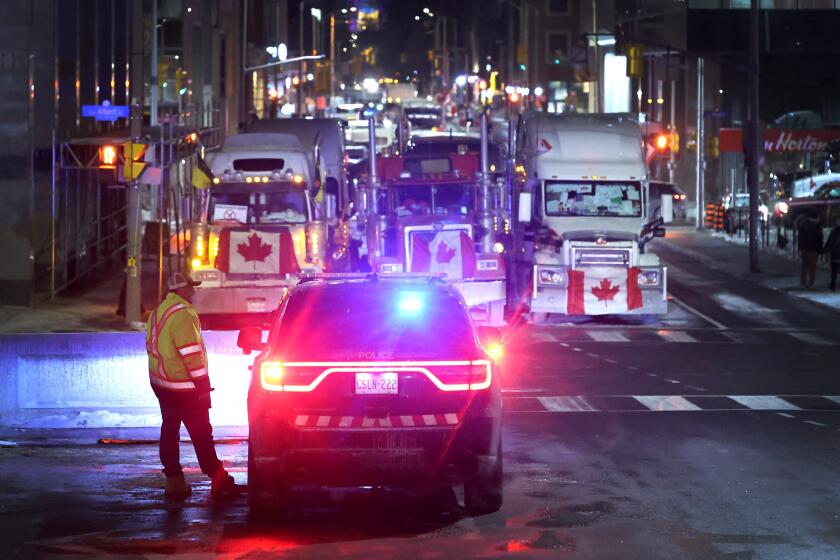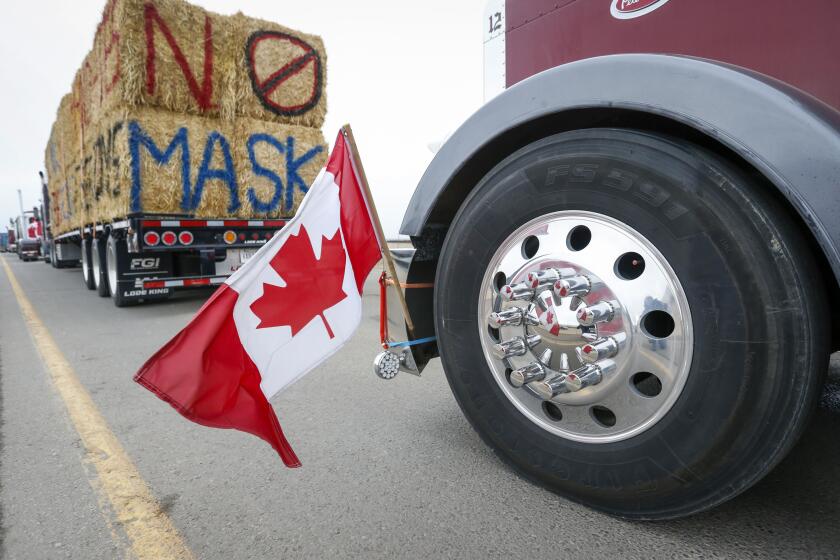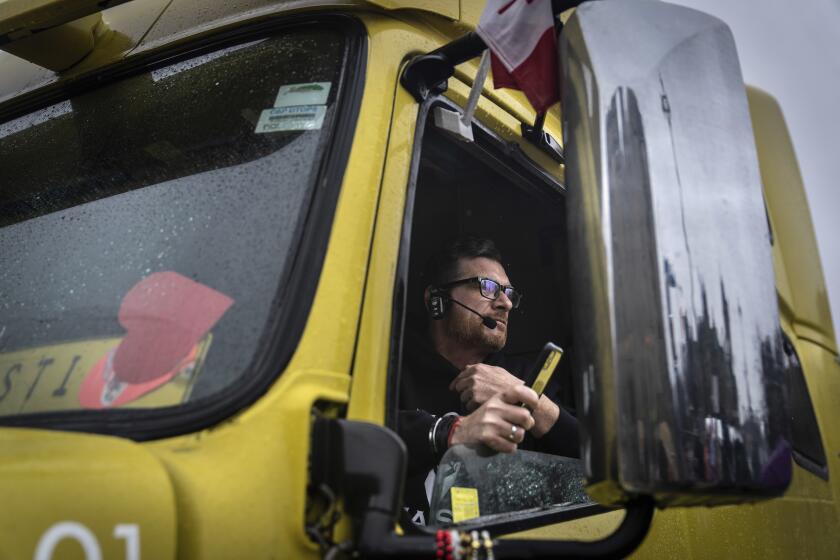Canada lawmakers extend emergency powers for truck protests

- Share via
TORONTO — Canadian lawmakers voted Monday night to extend the emergency powers that police can invoke to quell any potential restart of blockades by those opposed to COVID-19 restrictions.
Lawmakers in the House of Commons voted 185 to 151 to affirm the powers.
Prime Minister Justin Trudeau said earlier that the powers were still needed despite police ending the occupation of the nation’s capital by truckers over the weekend and police ending border blockades before that.
Emergency Preparedness Minister Bill Blair said the protesters were going for the “lifeblood of this nation, which is trade with the United States.”
Canada deals with images of truckers and others protesting against COVID-19 mandates and leveling other grievances, sometimes with vulgarity and incivility.
Trudeau noted there were some truckers just outside Ottawa who might be planning further blockades or occupations. His public safety minister said there was an attempt to block a border crossing in British Columbia over the weekend.
The emergencies act allows authorities to declare certain areas as no-go zones. It also allows police to freeze truckers’ personal and corporate bank accounts and compel tow truck companies to haul away vehicles.
The trucker protest grew until it closed a handful of Canada-U.S. border posts and shut down key parts of the capital for more than three weeks. But all border blockades have now ended and the streets around the Canadian Parliament are quiet.
Ottawa protesters who vowed never to give up are largely gone, chased away by police in riot gear in what was the biggest police operation in the nation’s history.
“The situation is still fragile, the state of emergency is still there,” Trudeau said before the vote.
Economies on both sides of the U.S.-Canada border are threatened by the blockade, with Detroit automakers starting to shut down plants.
Opposition New Democratic Party leader Jagmeet Singh’s party supported it, ensuring Trudeau had enough votes. Singh said they know there are protesters waiting in the surrounding areas of Ottawa and in the capital itself.
“They need to be cleared out,” said Singh, who also noted there have been convoys that have been intercepted.
“This is an attack on our democracy. This is a group of folks who are very clearly connected to the extreme right wing, The organizers clearly have a goal in mind to undermine democracy. That’s something we can’t allow to continue.”
The Royal Canadian Mounted Police said those who had their bank accounts frozen were “influencers in the illegal protest in Ottawa, and owners and/or drivers of vehicles who did not want to leave the area.”
Finance Minister Chrystia Freeland said earlier anyone affected has an easy way to have their accounts unfrozen: “Stop being a part of the blockade,” she said.
Public Safety Minister Marco Mendicino said allowing police to designate Ottawa’s downtown a no-go zone has been particularly effective. About 100 police checkpoints remain. “We saw calm, peace and quiet,” Mendicino said.
Prominent American conservatives who embrace the Canadian truckers protesting COVID-19 restrictions are drawing new accusations of hypocrisy.
The trucker protests grew until it closed a handful of Canada-U.S. border posts and shut down key parts of the capital city for more than three weeks.
“While we always will defend people’s right to opinion, expression and assembly, there are limits to rights when they begin to impact so severely on the rights of others and we saw that here in Ottawa,” said Blair, the emergency preparedness minister. “We also watched with growing concern as part of this protest group starting targeting critical infrastructure when they went to the border at Windsor.”
The protests, which were first aimed at a COVID-19 vaccine mandate for cross-border truckers but also encompassed fury over the range of COVID-19 restrictions and hatred of Trudeau, reflected the spread of disinformation in Canada and simmering populist and right-wing anger.
The self-styled Freedom Convoy shook Canada’s reputation for civility, inspired convoys in France, New Zealand and the Netherlands and interrupted trade, causing economic damage on both sides of the border. Hundreds of trucks eventually occupied the streets around Parliament, a display that was part protest and part carnival.
For almost a week, the busiest U.S.-Canada border crossing — the Ambassador Bridge between Windsor, Ontario, and Detroit — was blocked. The crossing sees more than 25% of the trade between the two countries.
Authorities moved to reopen the border posts, but police in Ottawa did little but issue warnings until Friday, even as hundreds and sometimes thousands of protesters clogged the streets of the city and besieged Parliament Hill.
One explanation for the reaction: The pandemic has been subsumed into the pre-existing culture war fight.
On Friday, authorities launched the largest police operation in Canadian history, arresting a string of Ottawa protesters and increasing that pressure on Saturday until the streets in front of Parliament were clear. Eventually, police arrested at least 191 people and towed away 79 vehicles. Many protesters retreated as the pressure increased.
Trudeau said people in Ottawa were harassed for weeks and said billions of dollars in trade were stalled by the border blockades, putting people’s jobs at risk.
The protests have been cheered on in the U.S. by Fox News personalities and conservatives such as former President Trump. Millions of dollars in donations have flowed across the border to the protesters.
“A flood of misinformation and disinformation washed over Canada, including from foreign sources,” Trudeau said.
“After these illegal blockades and occupations received disturbing amounts of foreign funding to destabilize Canada’s democracy, it became clear that local and provincial authorities needed more tools to restore order.”
More to Read
Sign up for Essential California
The most important California stories and recommendations in your inbox every morning.
You may occasionally receive promotional content from the Los Angeles Times.













